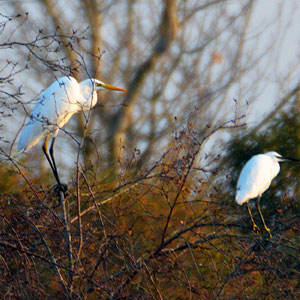Magazine | Analyses
Pourquoi voit-on de plus en plus de Grandes Aigrettes en France ?

Grande Aigrette (Ardea alba) et Aigrette garzette (Egretta garzetta), Gueltas (Morbihan), le 15 novembre 2011.Photographie : Chris Rickards
Introduction
Dans les années 1980, la Grande Aigrette (Ardea alba) était un visiteur hivernal rare en France, et il fallait se rendre dans des endroits précis pour l’observer, comme en Camargue, ou bien partir en Europe orientale. Jusqu’en 1986, elle faisait d’ailleurs partie de la liste des oiseaux rares du Comité d’Homologation National. Mais depuis les années 1990, on a assisté à une croissance exponentielle du nombre d’oiseaux vus en automne et en hiver dans l’hexagone. La Grande Aigrette y niche désormais localement. L’espèce est visible dans toutes les régions de France durant la saison internuptiale, parfois avec des effectifs impressionnants. Mais comment expliquer ce phénomène remarquable par son intensité ?
Abstract
The Great White Egret (Ardea alba) is a large egret distributed across most of the tropical and warmer temperate regions of the world. In Europe and North America, large numbers were killed around the end of the 19th century so that their feathers could be used to decorate hats. The species has also declined due to the destruction of numerous wetlands but also because of water pollution and pesticides. Up to the 1980s, the species was a rare winter visitor in France and in several countries of Western Europe, but since the 1990s, the number of wintering birds has exploded, and the species is now a localized breeder in France. How could this spectacular phenomenon be explained?
Poursuivez la lecture de cet article, en vous abonnant dès maintenant !
Découvrez les Archives d’Ornithomedia.com
Pour seulement 10,00 €TTC/an (ou 6,00 € les 6 mois)
Profitez de plusieurs centaines d’articles en accès illimité et sans aucun engagement.
Compléments
À lire aussi sur Ornithomedia.com
Le Domaine de Lindre, le spot aux aigles pêcheurs
Les observations sur Ornithomedia.com
Dans la galerie photos d’Ornithomedia.com
Ouvrage recommandé
Le guide Ornitho de Killian Mullarney
Sources
- Anne McTavish (2011). The Biogeography of the Great Egret (Ardea alba egretta). San Francisco State University Department of Geography. http://bss.sfsu.edu/holzman/courses/Fall01%20projects/gEgretWeb.htm
- Heike K. Lotze (2005). Radical changes in the Wadden Sea fauna and flora over the last 2,000 years. Helgoland Marine Research Volume 59, Numéro 1, 71-83. http://www.springerlink.com/content/7yhd3x8tduke1w22/
- Corif (2008). Loïc MARION : Evolution des populations de hérons arboricoles en France Résultats du 9e Recensement National des héronnières (Héron cendré, Héron pourpré, Héron bihoreau, Héron crabier, Héron garde-bœufs, Aigrette garzette, Grande aigrette). 32e Colloque Francophone d’Ornithologie.
- Itsas Enara O.E. (2011). Llegada masiva de garcetas grandes a Plaiaundi. Itsas Eneara Ornitologia Elkartea. http://ieoe.blogspot.com/2011/09/llegada-masiva-de-garcetas-grandes.html
- Milan Vogrin (1999). The Great White Egret Egretta alba during autumn and winter on Dravsko polje in northeastern Slovenia. Ornis Hungarica 8-9: 33-37. http://kornel.zool.klte.hu/pub/ornis/articles/OrnisHungarica_vol8-9_p33-37.pdf
- Frédéric Dupuy (2002). Synthèse des observations de Grande Aigrette (Egretta alba) en Aquitaine de 1946 à 2001, et quelques données comportementales. Le courbageot n° 20. http://files.biolovision.net/www.faune-aquitaine.org/userfiles/Courbageot/Courba20-23.pdf
- Erwin Nemeth et Alexander Schuster (2005). Spatial and temporal variation of habitat and prey utilization in the Great White Egret Ardea alba alba at Lake Neusiedl, Austria: Capsule In eastern Austria, Great White Egrets used the extensive reed beds of Lake Neusiedl not only as nesting sites, but also as a major foraging area. Bird Study 52, 129–136. http://www.tandfonline.com/doi/pdf/10.1080/00063650509461382




Aucun commentaire sur ce sujet
Participer à la discussion !